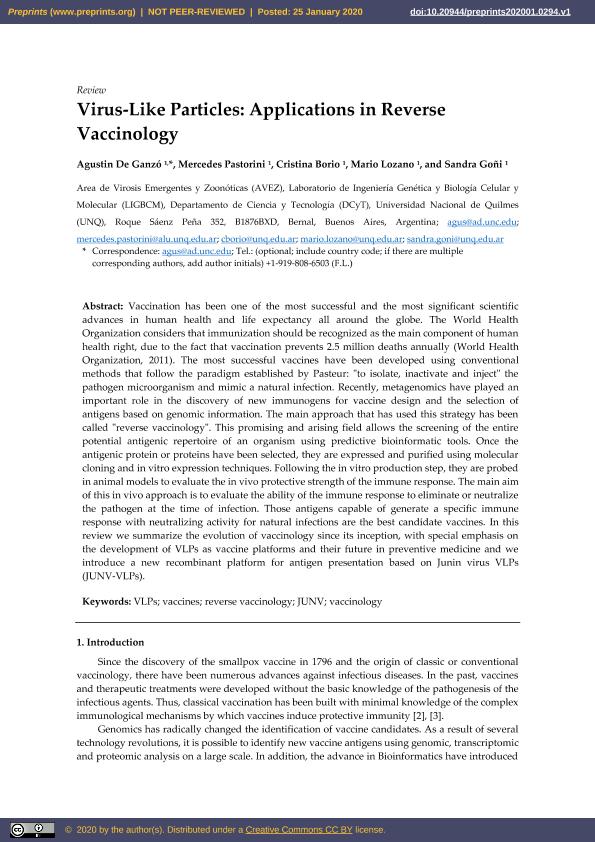Mostrar el registro sencillo del ítem
dc.contributor.author
de Ganzó, Agustín Francisco

dc.contributor.author
Pastorini, Mercedes

dc.contributor.author
Borio, Cristina Silvia

dc.contributor.author
Lozano, Mario Enrique

dc.contributor.author
Goñi, Sandra Elizabeth

dc.date.available
2021-11-08T17:35:46Z
dc.date.issued
2020-01-01
dc.identifier.citation
de Ganzó, Agustín Francisco; Pastorini, Mercedes; Borio, Cristina Silvia; Lozano, Mario Enrique; Goñi, Sandra Elizabeth; Virus-Like Particles: Applications in Reverse Vaccinology; Multidisciplinary Digital Publishing Institute; Preprints; 2020; 1-1-2020; 1-13
dc.identifier.issn
2310-287X
dc.identifier.uri
http://hdl.handle.net/11336/146307
dc.description.abstract
Vaccination has been one of the most successful and the most significant scientific advances in human health and life expectancy all around the globe. The World Health Organization considers that immunization should be recognized as the main component of human health right, due to the fact that vaccination prevents 2.5 million deaths annually (World Health Organization, 2011). The most successful vaccines have been developed using conventional methods that follow the paradigm established by Pasteur: "to isolate, inactivate and inject" the pathogen microorganism and mimic a natural infection. Recently, metagenomics have played an important role in the discovery of new immunogens for vaccine design and the selection of antigens based on genomic information. The main approach that has used this strategy has been called "reverse vaccinology". This promising and arising field allows the screening of the entire potential antigenic repertoire of an organism using predictive bioinformatic tools. Once the antigenic protein or proteins have been selected, they are expressed and purified using molecular cloning and in vitro expression techniques. Following the in vitro production step, they are probed in animal models to evaluate the in vivo protective strength of the immune response. The main aim of this in vivo approach is to evaluate the ability of the immune response to eliminate or neutralize the pathogen at the time of infection. Those antigens capable of generate a specific immune response with neutralizing activity for natural infections are the best candidate vaccines. In this review we summarize the evolution of vaccinology since its inception, with special emphasis on the development of VLPs as vaccine platforms and their future in preventive medicine and we introduce a new recombinant platform for antigen presentation based on Junin virus VLPs (JUNV-VLPs).
dc.format
application/pdf
dc.language.iso
eng
dc.publisher
Multidisciplinary Digital Publishing Institute
dc.rights
info:eu-repo/semantics/openAccess
dc.rights.uri
https://creativecommons.org/licenses/by/2.5/ar/
dc.subject
VACCINES
dc.subject
REVERSE VACCINOLOGY
dc.subject
VIRUS-LIKE PARTICLES
dc.subject
JUNV
dc.subject.classification
Biotecnología relacionada con la Salud

dc.subject.classification
Biotecnología de la Salud

dc.subject.classification
CIENCIAS MÉDICAS Y DE LA SALUD

dc.title
Virus-Like Particles: Applications in Reverse Vaccinology
dc.type
info:eu-repo/semantics/article
dc.type
info:ar-repo/semantics/artículo
dc.type
info:eu-repo/semantics/publishedVersion
dc.date.updated
2021-09-27T15:20:20Z
dc.identifier.eissn
2310-287X
dc.journal.volume
2020
dc.journal.pagination
1-13
dc.journal.pais
Suiza

dc.journal.ciudad
Basel
dc.description.fil
Fil: de Ganzó, Agustín Francisco. Universidad Nacional de Quilmes. Departamento de Ciencia y Tecnología. Laboratorio de Ingeniería Genética y Biología Molecular y Celular. Área de Virosis Emergentes y Zoonótica; Argentina. Consejo Nacional de Investigaciones Científicas y Técnicas; Argentina
dc.description.fil
Fil: Pastorini, Mercedes. Universidad Nacional de Quilmes. Departamento de Ciencia y Tecnología. Laboratorio de Ingeniería Genética y Biología Molecular y Celular. Área de Virosis Emergentes y Zoonótica; Argentina. Consejo Nacional de Investigaciones Científicas y Técnicas; Argentina
dc.description.fil
Fil: Borio, Cristina Silvia. Universidad Nacional de Quilmes. Departamento de Ciencia y Tecnología. Laboratorio de Ingeniería Genética y Biología Molecular y Celular. Área de Virosis Emergentes y Zoonótica; Argentina. Consejo Nacional de Investigaciones Científicas y Técnicas; Argentina
dc.description.fil
Fil: Lozano, Mario Enrique. Universidad Nacional de Quilmes. Departamento de Ciencia y Tecnología. Laboratorio de Ingeniería Genética y Biología Molecular y Celular. Área de Virosis Emergentes y Zoonótica; Argentina. Consejo Nacional de Investigaciones Científicas y Técnicas; Argentina
dc.description.fil
Fil: Goñi, Sandra Elizabeth. Universidad Nacional de Quilmes. Departamento de Ciencia y Tecnología. Laboratorio de Ingeniería Genética y Biología Molecular y Celular. Área de Virosis Emergentes y Zoonótica; Argentina. Consejo Nacional de Investigaciones Científicas y Técnicas; Argentina
dc.journal.title
Preprints
dc.relation.alternativeid
info:eu-repo/semantics/altIdentifier/url/https://www.preprints.org/manuscript/202001.0294/v1
dc.relation.alternativeid
info:eu-repo/semantics/altIdentifier/doi/http://dx.doi.org/10.20944/preprints202001.0294.v1
Archivos asociados
